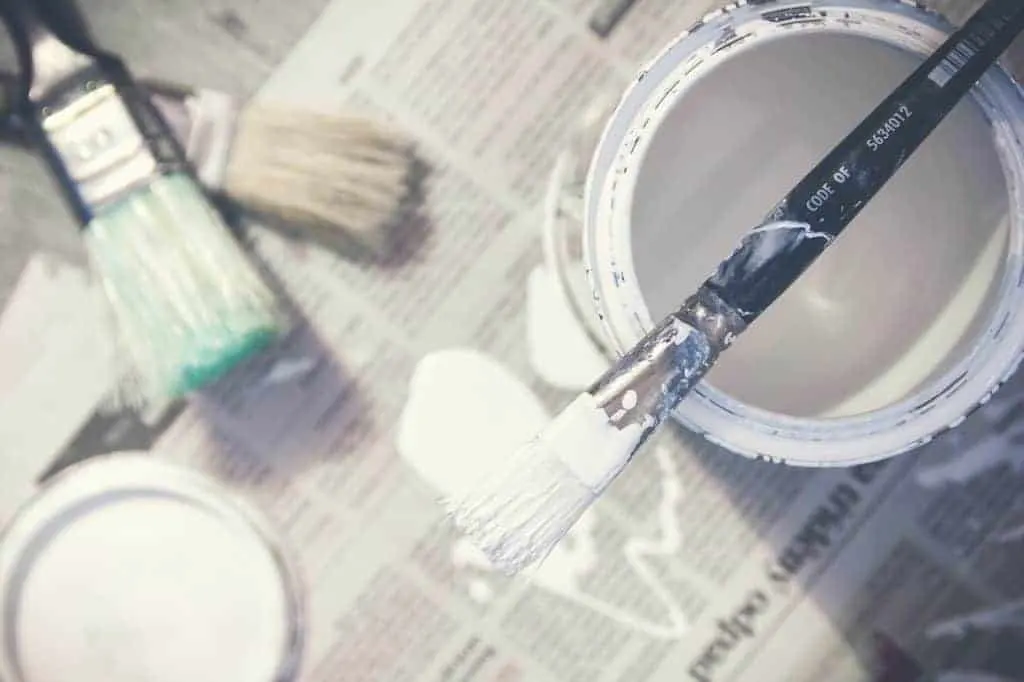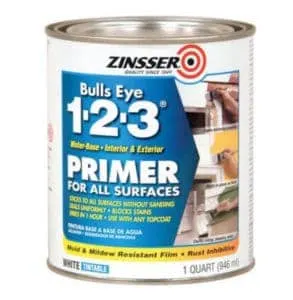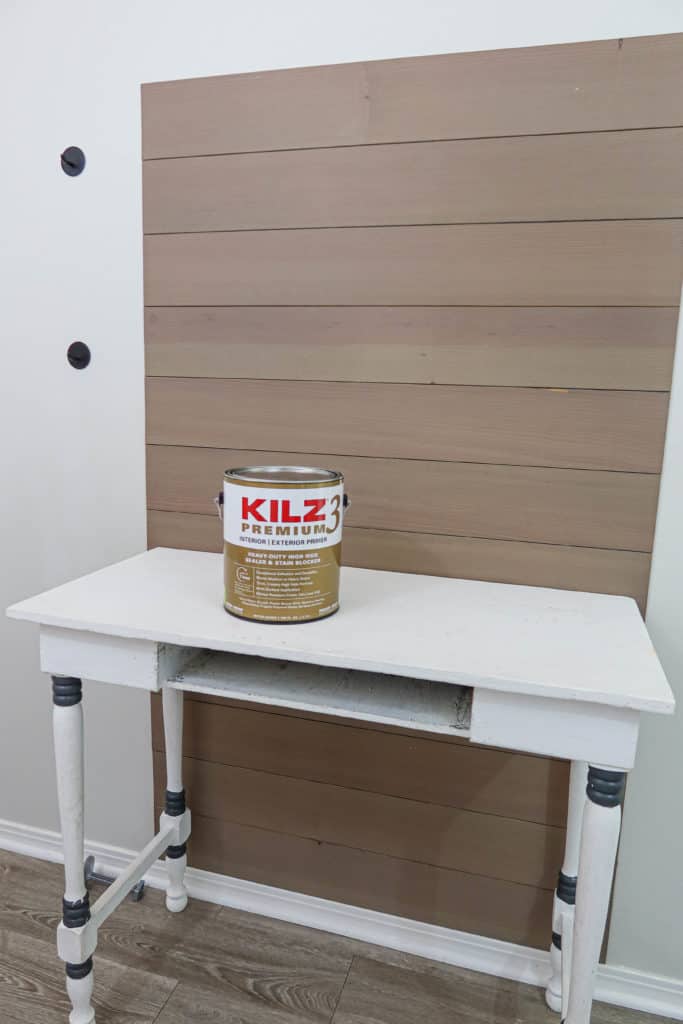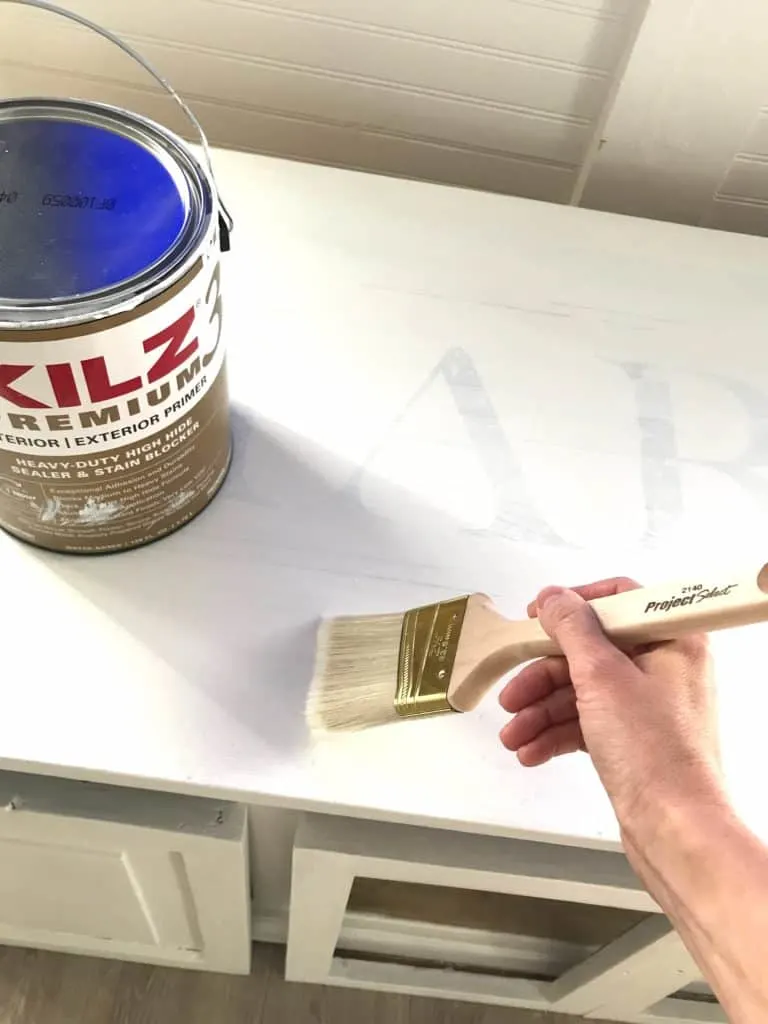Learn about the best primer for wood and antique wood furniture with a few examples of products that work great as well as a pros and cons list.
When it comes to painting furniture, most people will spend hours debating over color and type but forgo probably the most important decision to make; which primer.
You don’t really need a primer when using paint like chalk paint right? Wrong.
Primer is used for so much more than allowing a new coat of paint to stick to the surface or covering up a dark color with a light one. I won’t go into too much detail about that because I’ve got an entire post about why you need to use primer when painting furniture…even when using chalk paint. Some folks might even choose to use primer as the finish coat of paint (not a good idea).

If primer really is that important, then which type should you choose? There are so many different brands and products it can be overwhelming to know which primer to buy. Let me show you some of the best wood primers in this post!
Table of Contents
Choosing the Best Primer for Wood Furniture
When it comes to painting wood furniture, using a primer is essential to ensure the paint adheres properly and lasts longer. That being said it can be challenging to choose the best one. Here are some factors to consider when selecting the right primer for your wood furniture.
Consider the Wood Type
Different types of wood require different primers. For example, softwoods like pine and cedar are porous and absorbent, so they need a primer that can penetrate the wood fibers. On the other hand, hardwoods like oak and maple are less porous and require a primer that can create a smooth surface for the paint to adhere to.
Evaluate the Furniture Usage
Another factor to consider is how the furniture will be used. If it will be exposed to moisture or humidity, a primer with moisture-resistant properties is necessary. If the furniture will be subjected to wear and tear, a primer with high durability and scratch resistance is recommended.
When selecting a primer, it’s also important to consider the type of paint that will be used. Oil-based primers are ideal for oil-based paints, while water-based primers work best with latex paints. More on that, just keep reading…
Different types of primer and what to consider before choosing a primer
There are 3 types of primers:
- oil-based primer
- latex based primers (water-based primer)
- shellac based primers
Just keep in mind a few things;
- If you are going to use an oil based paint over a water based paint, make sure to use a water based primer first (shellac or latex).
- If you are going to use a water based paint over oil based paint, you can use oil or water based primer.
How To figure out what type of paint has been previously used on the surface
Pour a bit of acetone (nail polish remover) on a rag and wipe the surface with it. If the old paint rubs off on the rag then it’s latex or water-based paint. If it doesn’t wipe off then it’s oil-based paint.
Once you know more about the surface you are painting, proceed to deciding on the best primer.
I’m going to share my all time favorite primer products for wood furniture WITH real life pictures and my experience.
5 Best Primers for Wood and Antique Wood Furniture
- Zinsser Bulls Eye 1-2-3 All Surface Primer
- KILZ Premium High-Hide Stain Blocking Latex primer
- KILZ Adhesion High-Bonding Interior Latex Primer/Sealer
- General Finishes stain blocking primer
- Zinsser Shellac primer
Zinsser Bulls Eye All Surface Primer
This is my all time favorite primer. It is so versatile and can be used successfully with so many different types of surfaces. I’ve used it to paint laminate cabinets, paint IKEA furniture and cover countless wood furniture surfaces.

PROS
All purpose- works on most surfaces
Interior/exterior
High hiding, stain blocking
Great coverage
CONS
Doesn’t adhere quite as well as Shellac primers
This is my go to primer for virtually all projects mainly because it has great coverage and works well with so many different surfaces, especially all types of wood- from painted to stained to bare wood.
Kilz Premium High Hide Stain blocking latex primer
This primer is very useful for wood that has an odor, has been previously painted or stained and you need to properly seal the previous layer. I’ve used this primer on a few older wood furniture pieces and it’s covered the surface beautifully.
You can see I used it when I painted this antique desk with an Ombre effect. This desk reeked of smoke and old wood (even with a previous paint job). With only one coat of this primer it smelled and looked so much better! This is a great stain-blocking primer especially if you are working on an older piece of furniture that has been through a lot!

I also used this primer to cover a previously painted TV stand.

PROS
Great at hiding previous odors and stains
Seals well
Zero VOC’s
CONS
Thick formula
Doesn’t dry as evenly as others
Kilz Adhesion High Bonding Interior Latex primer
Kilz adhesion high bonding primer is great to use if you are worried about your new paint not adhering well. This is especially useful if you are trying to paint over a previously glossy or semi gloss finish.
PROS
Excellent at hiding stains and previous finishes
Bonds securely to even slick finishes
Quick dry time
CONS
Thick formula
General Finishes Stain Blocking Primer
General Finishes stain blocking primer is formulated specifically to hide old tannins and stains on wood. General finishes product’s aren’t cheap, but they are well worth the money. This product is great to use on bare wood surfaces as it will effectively block any tannins from the raw wood from seeping through the new paint.
PROS
High hide formula
Formulated specifically with highest quality ingredients
CONS
Expensive
Must apply two coats
Zinsser Shellac-based Primer
Zinsser Shellac primer is well known for its ability to bond well to any surface. Shellac-based primers are very effective at sealing wood from water stains and odors. This happens to be the go-to primer for many people when painting non wood surfaces like laminate. Beware that this type of primer is not supposed to be used in a paint sprayer.
PROS
Excellent bonding capabilities
Great at sealing odors and water damage
CONS
High VOC’s and fumes
Cleanup requires denatured alcohol
Best overall primer for wood furniture
Even though all of these primers are highly rated, our pick for the best overall primer for wood or wood furniture would be the Zinsser Bulls Eye 1-2-3 All Surface Primer for a few reasons:
- Best and most even coverage
- High hiding capabilities
- Low to no VOC’s
- Easy cleanup
- Adheres to a wide variety of surfaces
Tip to hide the wood grain before painting
As a side note, if you are painting a wood surface that has a heavy wood grain (like Oak) and you want it to look smooth, try mixing some wood filler with water and apply it over the surface. After it’s fully dry, sand it smooth and then apply your favorite primer.
Application Techniques for Primers on Wood Furniture
When applying primer to wood furniture, there are a few techniques that can help ensure a smooth and even finish.
First, it’s important to properly prepare the surface of the wood. This includes sanding the wood to create a smooth surface, removing any dust or debris, and cleaning the wood with a damp cloth or tack cloth.
Next, apply the primer in thin, even coats. Using a brush, roller, or paint sprayer, start at the top of the furniture piece and work your way down. Be sure to follow the manufacturer’s instructions for drying time between coats.
If you notice any drips or uneven spots, lightly sand the area and apply another coat of primer. It’s better to apply multiple thin coats than one thick coat, as this can lead to uneven drying and a rough finish.
Finally, once the primer has fully dried, you can begin using your paint product.
Common Mistakes When Priming Wood Furniture
When it comes to priming wood furniture, there are a few common mistakes that people make that can lead to a less-than-perfect finish. Here are some of the most common mistakes to avoid:
1. Not Sanding the Wood
Even though sanding before priming isn’t always necessary, it helps create a smooth surface for the primer to adhere to, which will helps the paint stick better. If you are looking for a clean, smooth finish, go ahead and sand first.
2. Using the Wrong Primer
Another common mistake is using the wrong type of primer. It’s important to choose a primer that is specifically designed for use on wood surfaces AND is compatible with the type of paint you are going to use. Using the wrong type of primer can lead to poor adhesion and a less-than-perfect finish.
3. Applying Too Much Primer
Applying too much primer can also be a problem. While it may seem like applying more primer will lead to a better finish, it can actually lead to a rough, uneven surface. It’s important to apply primer in thin, even coats and allow each coat to dry completely before applying the next.
4. Rushing the Drying Process
Finally, rushing the drying process can also be a mistake. It’s important to allow each coat of primer to dry completely before moving on to the next step. Rushing the drying process may even cause the primer to peel or crack over time.
More about good primer products:
Are you looking for a primer to paint your cabinets? Check out our list of the five best primer for cabinets here!

Check out more of my Paint reviews below:
Best White Paint Products for Kitchen Cabinets
Valspar Cabinet and Furniture Paint Review
Best Metallic Paint for Furniture
Heirloom Traditions All-in-One paint review
Valspar One-Coat Exterior stain and sealer in solid review
I hope this list has helped you decide which primer to use. Thanks for stopping by!
Lindsey**

Leave a comment